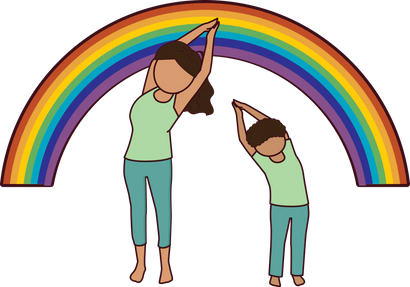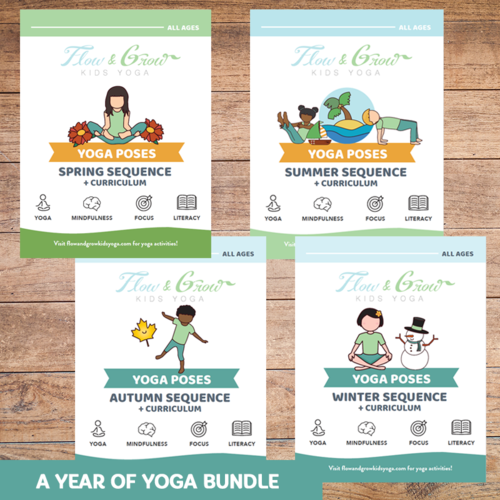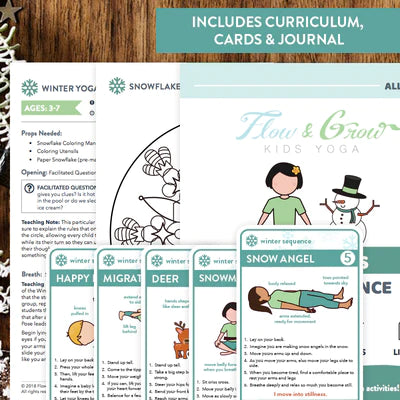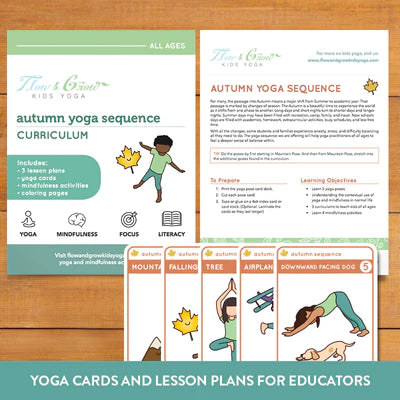Your Cart is Empty
22% off Automatically at checkout when you spend $5 of more!
22% off Automatically at checkout when you spend $5 of more!

How Social and Emotional Learning and Yoga Help Kids Breathe Through Big Emotions
by Kane SEO April 14, 2025 4 min read
In classrooms and communities around the world, educators and parents alike are placing a growing emphasis onsocial and emotional learning. And for good reason: helping children understand, manage, and express their emotions in healthy ways is just as critical as teaching them to read or do math. But what happens when a child feels overwhelmed by anxiety, frustration, or sadness? How do we give them tools not just to survive emotionally, but to thrive?
That’s wheresocial-emotional learning meets mindful movement—and specifically, yoga.
What is Social and Emotional Learning (SEL)?

Social and emotional learning (SEL) is the process by which individuals—especially children—learn to recognize and manage emotions, set and achieve goals, show empathy for others, build healthy relationships, and make responsible decisions. SEL is backed by decades of research showing that it leads to improved academic outcomes, reduced behavioral problems, and better mental health.
The National Education Association (NEA) highlights SEL as a transformative educational strategy that benefits every student. Their article “The Truth About SEL: It Works” points to key data showing that SEL improves student performance by 11 percentile points and fosters more positive classroom climates. SEL also helps build long-term skills for life beyond school, including conflict resolution, self-discipline, and resilience.
But for SEL to truly take root, it must go beyond textbooks and worksheets. It needs to be embodied. It needs to be practiced—quite literally—with the body, the breath, and the heart.
That’s where yoga comes in.
The Role of Yoga in Social and Emotional Learning
Yoga, particularly for children, is more than just stretching or striking poses—it’s a powerful tool to connect the body and mind, develop self-awareness, and regulate emotions. When paired with SEL, yoga offers a physical and mindful framework for practicing the skills that social and emotional learning teaches.
At Flow and Grow Kids Yoga, one of the core strategies used to support SEL isbreathwork—simple, engaging breathing exercises that help children shift their emotional state in the moment. Their blog post,“4 Breaths to Try With Four Different Emotions”, introduces easy breathwork techniques tied to specific emotional experiences.
Here’s how these breathing tools can support SEL development in kids:
1. Bumblebee Breath for Anxiety

When a child is feeling anxious, their nervous system is often in fight-or-flight mode. TheBumblebee Breath is a calming breath that uses sound and vibration to soothe the body and mind.
How to Do It:
-
Sit comfortably with hands resting on knees.
-
Inhale deeply through the nose.
-
Exhale with a gentle “hummmm” sound, like a bumblebee.
-
Repeat several times.
SEL Connection: This breath helps children recognize their anxiety and take active steps to calm themselves—key skills in self-awareness and self-management.
2. Breath of Joy for Sadness
Sadness often manifests as a low-energy emotion. The Breath of Joy is a dynamic, energizing breath that can lift the mood and bring in a sense of lightness.
How to Do It:
-
Stand tall and take three short, sharp inhalations through the nose while raising the arms in different directions.
-
Exhale strongly through the mouth while swinging the arms down.
SEL Connection: This breath encourages emotional expression and helps children recognize that they can shift their mood with movement and breath—a powerful lesson in emotional regulation.
3. Power of the Sun Breath for Fatigue

When kids feel tired or disengaged, their focus drops, and they may struggle to stay present. The Power of the Sun Breath activates the solar plexus (our center of personal power) and invigorates the body.
How to Do It:
-
Start in Mountain Pose with hands near the belly.
-
Inhale and sweep the arms up overhead.
-
Exhale with a strong “HA” sound while drawing the arms back down into fists.
SEL Connection: This breath helps kids energize themselves and build a connection between their physical and emotional state—fostering both self-regulation and motivation.
Bringing Breath and SEL Into the Classroom and Home
Integrating breathwork and yoga with SEL doesn’t require a full curriculum overhaul. Here are a few simple ways educators and caregivers can start weaving these practices into daily life:
-
Morning Check-ins: Begin the day with a breath like Ocean or Bumblebee to help children arrive and feel grounded.
-
Transition Tools: Use Breath of Joy during transitions between subjects or activities to shift energy and focus.
-
Emotion Check-Ins: Pair each breath with emotional vocabulary. “How are you feeling right now? Which breath would help?”
-
Modeling and Reflection: Practice the breaths yourself. Children learn emotional regulation by observing the adults around them.
Why It Matters Now More Than Ever
In a world still healing from the disruptions of the pandemic, children are navigating an emotional landscape that is more complex than ever. SEL is no longer optional—it’s essential. And the good news is, it works. SEL gives kids the tools to navigate life’s challenges with compassion, awareness, and strength.
When combined with yoga and mindful breathwork, SEL becomes more than theory—it becomes an embodied practice. A way of living.
As the team at Flow and Grow Kids Yoga beautifully demonstrates, something as simple as a breath can be a powerful tool for transformation.
Final Thoughts
Social and emotional learning isn't just about managing emotions—it’s about empowering children to build meaningful relationships, express themselves authentically, and cultivate resilience. When paired with yoga and breathwork, SEL becomes a whole-body practice that children can carry with them for life.
By making time for these mindful moments—whether in a classroom or at the kitchen table—we help our children not just breathe better, butbe better.
Leave a comment
Comments will be approved before showing up.
Also in Kids Yoga Blog
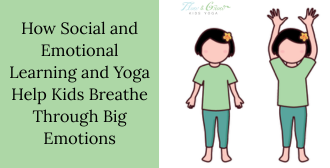
How Social and Emotional Learning and Yoga Help Kids Breathe Through Big Emotions
by Kane SEO April 21, 2025 4 min read

Power of Yoga for Kids: How It Helps Them Grow, Focus, and Thrive
by Kane SEO March 25, 2025 5 min read
In today’s fast-paced world, children are often exposed to stressors from a young age, whether it’s academic pressure, social challenges, or the overwhelming influence of digital devices. This can impact their physical, mental, and emotional well-being.
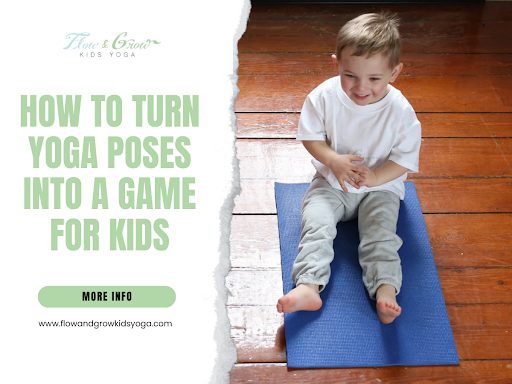
How to Turn Yoga Poses into a Game for Kids
by Kane SEO March 21, 2025 5 min read
Yoga is a wonderful way for children to stay active, develop flexibility, and improve focus. However, young kids can often lose interest quickly, especially when it’s just about holding poses or talking about yoga.
Ultimate Kids Year of Yoga Bundle
bundlespricey-contentdigital-resourcesearly-childhood-yoga-mindfulnesselementary-yoga-mindfulnesskids-yoga-resourcesmiddle-high-school-yoga-mindfulnessseasonal-yogayoga-cards
Ultimate Kids Year of Yoga Bundle
5 reviews
5.0 / 5.0
(5) 5 total reviews
$45.00
Ultimate Kids Year of Yoga Bundle
5 reviews
5.0 / 5.0
(5) 5 total reviews
$45.00
Kid’s Sun Salutation Yoga Cards
digital-resourcesearly-childhood-yoga-mindfulnesselementary-yoga-mindfulnesskids-yoga-resourcesliteracyunder-15yoga-cards
Kid’s Sun Salutation Yoga Cards
3 reviews
4.33 / 5.0
(3) 3 total reviews
$10.00
Kid’s Sun Salutation Yoga Cards
3 reviews
4.33 / 5.0
(3) 3 total reviews
$10.00
Yamas and Niyamas: Successful Relationships with Self & Others (tweens and teens)
pricey-contentdigital-resourceskids-yoga-resourceslesson-plansmiddle-high-school-yoga-mindfulnessmindfulness
Yamas and Niyamas: Successful Relationships with Self & Others (tweens and teens)
2 reviews
5.0 / 5.0
(2) 2 total reviews
$49.00$55.00
Yamas and Niyamas: Successful Relationships with Self & Others (tweens and teens)
2 reviews
5.0 / 5.0
(2) 2 total reviews
$49.00$55.00
